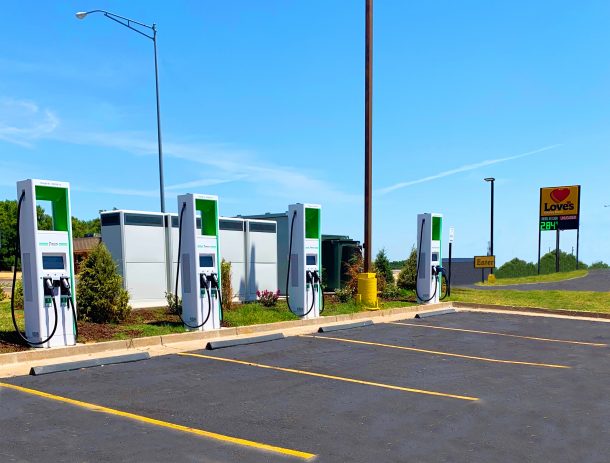Love's Truck Stops Adding EV Charging Stations

Electrify America, the U.S. company Volkswagen had to create as part of its diesel emissions penance, announced Wednesday that it will work with Love’s Travel Stops to bring ultra-fast electric vehicle charging stations to seven locations in half a dozen states.
While much of the group’s work has revolved around servicing areas (often through business partnerships) where EVs tend to proliferate, the plan has also been to bolster the national charging infrastructure by providing routes that could help facilitate long-distance travel.
The new charging stations — located in Oklahoma, New Mexico, Utah, Florida, New York and Arizona — will account for a combined 28 EV chargers and should available for public use by early 2021. In its announcement, Electrify America said previous work with Love’s allowed it to complete a cross-country route between Los Angeles to Washington, D.C.
While a drop in the bucket in terms of nationwide charging coverage, partnering with Love’s seems a wise move. With over 500 locations in most American states, the travel stops tend to be among the better options for those journeying long distances. They’re also usually designed with sufficient distractions and amenities to make waiting for a recharge easier to endure. The deal is good for Love’s as well, since EV drivers will be required to linger a bit longer than their gasoline-dependent contemporaries — likely leading to additional purchases.
“As we continue building charging stations at accessible sites, Love’s Travel Stops was a perfect fit because of its convenient locations near major highways,” said Rachel Moses, senior manager for site acquisition, development and strategy at Electrify America. “Providing EV drivers with the opportunity to charge their vehicles at Love’s locations will help instill confidence for longer interstate trips, and can encourage more consumers to consider making the switch to electric.”
Electrify America said Love’s customers will have access to chargers ranging in power from 150 kilowatt (kW) to 350 kW — depending on location. Five of the sites are already open, with the planned stations in New York and Arizona being added “soon.”
While taking a company at its word is always perilous, Electrify America has done a pretty good job at establishing functional charging routes between states. Granted, you’re totally out of luck if you happen do be driving through North Dakota. Yet a cross-country journey is still possible with a little advanced planning, and coastal trips (which have the highest density of chargers) should be easier still.
The company also has helpful map of its station locations one could peruse before setting out, and the map proves that it’s been quite busy over the past few years. But it’s still only a sliver of what the country needs before EVs can be driven around as carefree as gas-powered automobiles. Large gaps in the nation’s charging infrastructure remain, and many more rural and remote charging sites will need to be added if electrification is ever to go mainstream.
[Image: Electrify America]

A staunch consumer advocate tracking industry trends and regulation. Before joining TTAC, Matt spent a decade working for marketing and research firms based in NYC. Clients included several of the world’s largest automakers, global tire brands, and aftermarket part suppliers. Dissatisfied with the corporate world and resentful of having to wear suits everyday, he pivoted to writing about cars. Since then, that man has become an ardent supporter of the right-to-repair movement, been interviewed on the auto industry by national radio broadcasts, driven more rental cars than anyone ever should, participated in amateur rallying events, and received the requisite minimum training as sanctioned by the SCCA. Handy with a wrench, Matt grew up surrounded by Detroit auto workers and managed to get a pizza delivery job before he was legally eligible. He later found himself driving box trucks through Manhattan, guaranteeing future sympathy for actual truckers. He continues to conduct research pertaining to the automotive sector as an independent contractor and has since moved back to his native Michigan, closer to where the cars are born. A contrarian, Matt claims to prefer understeer — stating that front and all-wheel drive vehicles cater best to his driving style.
More by Matt Posky
Latest Car Reviews
Read moreLatest Product Reviews
Read moreRecent Comments
- ToolGuy I am slashing my food budget by 1%.
- ToolGuy TG grows skeptical about his government protecting him from bad decisions.
- Calrson Fan Jeff - Agree with what you said. I think currently an EV pick-up could work in a commercial/fleet application. As someone on this site stated, w/current tech. battery vehicles just do not scale well. EBFlex - No one wanted to hate the Cyber Truck more than me but I can't ignore all the new technology and innovative thinking that went into it. There is a lot I like about it. GM, Ford & Ram should incorporate some it's design cues into their ICE trucks.
- Michael S6 Very confusing if the move is permanent or temporary.
- Jrhurren Worked in Detroit 18 years, live 20 minutes away. Ren Cen is a gem, but a very terrible design inside. I’m surprised GM stuck it out as long as they did there.


































Comments
Join the conversation
"the plan has also been to bolster the national charging infrastructure by providing routes that could help facilitate long-distance travel." Yes - good plan. Installing chargers where people don't need them is a waste of time, and is the reason some charging companies have failed. I think of this every time I see a charger at a grocery story or an urban parking garage. EVs arriving at these spots have already charged at home, and have likely traveled only a short distance.
Since Love's is primarily a rural watering hole, I expect a lot of these to be blocked by good ol' boys in their brodozers.